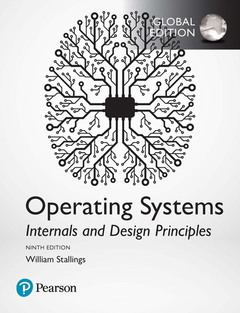Operating Systems: Internals and Design Principles, Global Edition (9th Ed.)
Auteur : Stallings William

For one- or two-semester undergraduate courses in operating systems for computer science, computer engineering, and electrical engineering majors
An introduction to operating systems with up-to-date and comprehensive coverage
Now in its 9th Edition, Operating Systems: Internals and Design Principles provides a comprehensive, unified introduction to operating systems topics aimed at computer science, computer engineering, and electrical engineering majors. Author William Stallings emphasises both design issues and fundamental principles in contemporary systems, while providing readers with a solid understanding of the key structures and mechanisms of operating systems. He discusses design trade-offs and the practical decisions affecting design, performance and security. The text illustrates and reinforces design concepts, tying them to real-world design choices with case studies in Linux, UNIX, Android, and Windows 10.
With an unparalleled degree of support for integrating projects into the course, plus comprehensive coverage of the latest trends and developments in operating systems, including cloud computing and the Internet of Things (IoT), the text provides everything students and instructors need to keep pace with a complex and rapidly changing field. The 9th Edition has been extensively revised and contains new material, new projects, and updated chapters.
Online Chapters and Appendices
VideoNotes
Preface
About the Author
I. Background
1. Computer System Overview
1.1. Basic Elements
1.2. Evolution of the Microprocessor
1.3. Instruction Execution
1.4. Interrupts
1.5. The Memory Hierarchy
1.6. Cache Memory
1.7. Direct Memory Access
1.8. Multiprocessor and Multicore Organization
1.9. Key Terms, Review Questions, and Problems
1A. Performance Characteristics of Two-Level Memories
2. Operating System Overview
2.1. Operating System Objectives and Functions
2.2. The Evolution of Operating Systems
2.3. Major Achievements
2.4. Developments Leading to Modern Operating Systems
2.5. Fault Tolerance
2.6. Os Design Considerations for Multiprocessor and Multicore
2.7. Microsoft Windows Overview
2.8. Traditional Unix Systems
2.9. Modern Unix Systems
2.10. Linux
2.11. Android
2.12. Key Terms, Review Questions, and Problems
II. Processes
3. Process Description and Control
3.1. What is a Process?
3.2. Process States
3.3. Process Description
3.4. Process Control
3.5. Execution of the Operating System
3.6. Unix Svr4 Process Management
3.7. Summary
3.8. Key Terms, Review Questions, and Problems
4. Threads
4.1. Processes and Threads
4.2. Types of Threads
4.3. Multicore and Multithreading
4.4. Windows Process and Thread Management
4.5. Solaris Thread and Smp Management
4.6. Linux Process and Thread Management
4.7. Android Process and Thread Management
4.8. Mac OS X Grand Central Dispatch
4.9. Summary
4.10. Key Terms, Review Questions, and Problems
5. Concurrency: Mutual Exclusion and Synchronization
5.1. Mutual Exclusion: Software Approaches
5.2. Principles of Concurrency
5.3. Mutual Exclusion: Hardware Support
5.4. Semaphores
5.5. Monitors
5.6. Message Passing
5.7. Readers/Writers Problem
5.8. Summary
5.9. Key Terms, Review Questions, and Problems
6. Concurrency: Deadlock and Starvation
6.1. Principles of Deadlock
6.2. Deadlock Prevention
6.3. Deadlock Avoidance
6.4. Deadlock Detection
6.5. An Integrated Deadlock Strategy
6.6. Dining Philosophers Problem
6.7. Unix Concurrency Mechanisms
6.8. Linux Kernel Concurrency Mechanisms
6.9. Solaris Thread Synchronization Primitives
6.10. Windows Concurrency Mechanisms
6.11. Android Interprocess Communication
6.12. Summary
6.13. Key Terms, Review Questions, and Problems
III. Memory
7. Memory Management
7.1. Memory Management Requirements
7.2. Memory Partitioning
7.3. Paging
7.4. Segmentation
7.5. Summary
7.6. Key Terms, Review Questions, and Problems
7A. Loading and Linking
8. Virtual Memory
8.1. Hardware and Control Structures
8.2. Operating System Software
8.3. Unix and Solaris Memory Management
8.4. Linux Memory Management
8.5. Windows Memory Management
8.6. Android Memory Management
8.7. Summary
8.8. Key Terms, Review Questions, and Problems
IV. Scheduling
9. Uniprocessor Scheduling
9.1. Types of Processor Scheduling
9.2. Scheduling Algorithms
9.3. Traditional Unix Scheduling
9.4. Summary
9.5. Key Terms, Review Questions, and Problems
<
Comprehensive and updated coverage on the field operating systems
- This edition was extensively reviewed by a number of professors who teach the subject and by professionals working in the field. As a result, the narrative has been clarified and tightened, and illustrations have been improved.
- Four operating systems serve as running examples to illustrate the concepts and to tie them to real-world design choices that must be made: Linux, UNIX, Android, and Windows 10.
- The book includes a number of pedagogic features, including the use of animations and videonotes and numerous figures and tables to clarify the discussion.
- Each chapter includes a list of keywords, review questions, and homework problems.
- Design concepts discussed in a given chapter are immediately reinforced with real-world examples.
- Running case studies, focused on how specific operating systems implement specific concepts, illustrate concepts and are embedded throughout the text, rather than assembled as a single chapter or appendix.
- Projects: This text provides an unparalleled degree of support for including a projects component in the course.
Date de parution : 09-2017
Ouvrage de 800 p.
18x23 cm


